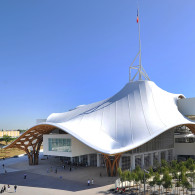Top French Cities - Grenoble at a glance
For more information, visit the Grenoble Tourism Office at www.grenoble-tourisme.com.
City region: The Alps / Auvergne-Rhône-Alpes
Population & what they are called: 163,625 inhabitants (2014 census), called Grenoblois
Access from Paris:
by road: about 5 h 15 min (357 miles) via A6 autoroute du Soleil
by train: about 3 hours by TGV from the Gare de Lyon
Famous native daughters & sons:
Stendhal, writer
Calogero, singer
Jean-Claude Gallotta, dancer and choreographer
Most distinctive and/or unique fact or trait (or little known fact):
Some historians date the start of the French Revolution to the Day of Tiles (Journée des Tuiles), a revolt that took place in Grenoble on June 7, 1788.
Grenoble has the second largest English-speaking community in France, after Paris.
Notable sites:
Fort de la Bastille – old fortifications built on the mountainside, reached by cable car, with superb views of the city
Vieille Ville – historic center filled with cobblestone streets and picturesque squares
Palais du Parlement du Dauphiné – Renaissance palace used as the Dauphiné Parliament until the French Revolution
Top annual events:
Rencontres Ciné Montagne – a unique mountain-centric festival of films, workshops and conferences, the biggest of its kind in Europe (grenoble-montagne.com)
Grenoble Street Art Fest – Europe’s first festival of street art as a multidisciplinary art, featuring frescoes, collages, stencil work, sculptures, photography, digital art, videos and more (streetartfest.org)
Cabaret Frappé – a free, summer, open-air music festival (cabaret-frappe.com)
Most notable museums:
Musée de Grenoble – renowned for its extensive paintings collection, but also sculptures and antiquities (museedegrenoble.fr)
Musée Archéologique Grenoble-Saint Laurent – presents the archeological excavations done on location (musee-archeologique-grenoble.fr)
Musée de la Révolution Française – located in the Vizille Chateau, the only museum in the world dedicated to this key period in French history (domaine-vizille.fr)
Culinary specialties:
walnuts – in 1938, the noix de Grenoble was the first fruit to receive an Appellation d’Origine Contrôlée (AOC)
cheese – two local-area standouts are Saint-Marcellin and Bleu du Vercors Sassenage
murçon de la Matheysine – local boiled pork sausage with aniseed flavor
Local wines & spirits:
Chartreuse – the only liqueur in the world with a completely natural green color, a product of distilled alcohol aged with 130 herbs, plants and flowers
Bières de Sassenage – one of the beers produced at the Brasserie des Cuves is called Sacrebleu, the first European blue beer with a 100% natural color (brasseriedescuves.fr)
Shopping:
Vieille Ville et Championnet – shops selling designer clothes, art and amazing chocolates
Halles Sainte-Claire – a huge, classic, covered market packed with fruits, vegetables, pastries, cheeses, meats etc.
La Caserne De Bonne – 50 shops in the De Bonne eco-district
Most popular night spots:
La Belle ÉlÈctrique – artistic and cultural project that spotlights amplified music: jazz, rock, pop, techno, fusion and more
La Bobine – concerts, bar, restaurant, exhibitions, theater etc.
Mark XIII – Friendly bar with DJ electro sets and cyber-goth-punk atmosphere
Local population’s favorite activities (or hangouts):
Jardin des Dauphins – the city's most luscious garden and a perfect place for a sunny stroll
MC2 (for Maison de la culture) – Grenoble's main cultural center, which hosts music, theater, and dance performances (mc2grenoble.fr)
Local industries:
FrenchTech – Grenoble was recognized for its growth in high-tech industries, including biotechnology and nanotechnology
scientific research – Grenoble is a major scientific research center (second only to Paris) focused on physics, computer science and applied mathematics
In Pop Culture:
electronic music – pioneered in Grenoble since the 1990s by the likes of The Hacker (Michel Amato), Miss Kittin, Oxia and others
The Trilogy (On the Run [Cavale], An Amazing Couple [Un couple épatant] and After Life [Après la vie]) – three separate feature films by Lucas Belvax, each set in Grenoble over the same few days in the lives of six characters
13 Days in France (13 jours en France) — a documentary about the 1968 Winter Olympics in Grenoble, directed by Claude Lelouch and François Reichenbach











